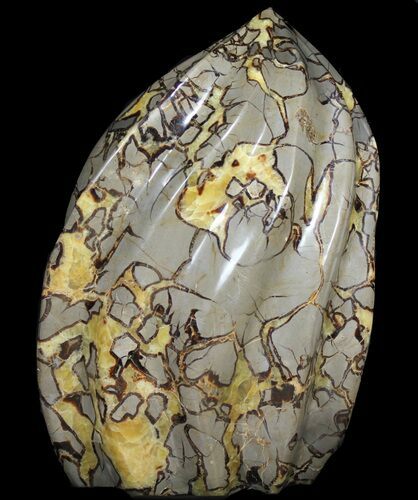This Specimen has been sold.
188 LB Polished Septarian Flame - US Shipping Included
Updated: Domestic shipping via UPS freight is included in the purchase price. International shipping is extra and will be billed after purchase. If you need an International shipping quote please contact us.
This is a HUGE septarian nodule that has been polished into a 2 foot high, free-standing sculpture. It weighs 188 lbs and would great as a decorative display piece. I don't think I've ever seen a single piece of septarian this large before.
This is a HUGE septarian nodule that has been polished into a 2 foot high, free-standing sculpture. It weighs 188 lbs and would great as a decorative display piece. I don't think I've ever seen a single piece of septarian this large before.
About Septarian
Septarian or septarian nodules are concretions containing angular cavities or cracks, called "septaria", filled with calcite and aragonite. A concretion is a hard, compact mass of rock that often forms around decaying organic matter. In the case of septarian nodules, the concretions formed around decaying sea life in a marine environment.
The exact mechanism for how the cracks form in the concretions is a mystery. One possible mechanism is the dehydration of the clay-rich core of a concretion, causing it to shrink and crack. The cracks could also be caused by gas expansion produced by the decaying organic matter within a concretion. Earthquakes have also been suggested as yet another mechanism.
The cracks in the concretions are then filled in with minerals such as calcite (yellow), aragonite (brown), and sometimes pyrite, causing very interesting patterns. They have often been described as looking like dragon's skin. They are frequently found as geodes with hollow, calcite crystal-filled cavities. More rarely, the fossils that originally started the formation of the concretion are still preserved in the septarian.
Septarian or septarian nodules are concretions containing angular cavities or cracks, called "septaria", filled with calcite and aragonite. A concretion is a hard, compact mass of rock that often forms around decaying organic matter. In the case of septarian nodules, the concretions formed around decaying sea life in a marine environment.
The exact mechanism for how the cracks form in the concretions is a mystery. One possible mechanism is the dehydration of the clay-rich core of a concretion, causing it to shrink and crack. The cracks could also be caused by gas expansion produced by the decaying organic matter within a concretion. Earthquakes have also been suggested as yet another mechanism.
The cracks in the concretions are then filled in with minerals such as calcite (yellow), aragonite (brown), and sometimes pyrite, causing very interesting patterns. They have often been described as looking like dragon's skin. They are frequently found as geodes with hollow, calcite crystal-filled cavities. More rarely, the fossils that originally started the formation of the concretion are still preserved in the septarian.
SPECIES
Septarian
LOCATION
Ambondromamy, Betsiboka Region, Madagascar
SIZE
24" tall, 17" wide, 188 lbs
CATEGORY
ITEM
#39065
 Reviews
Reviews


















